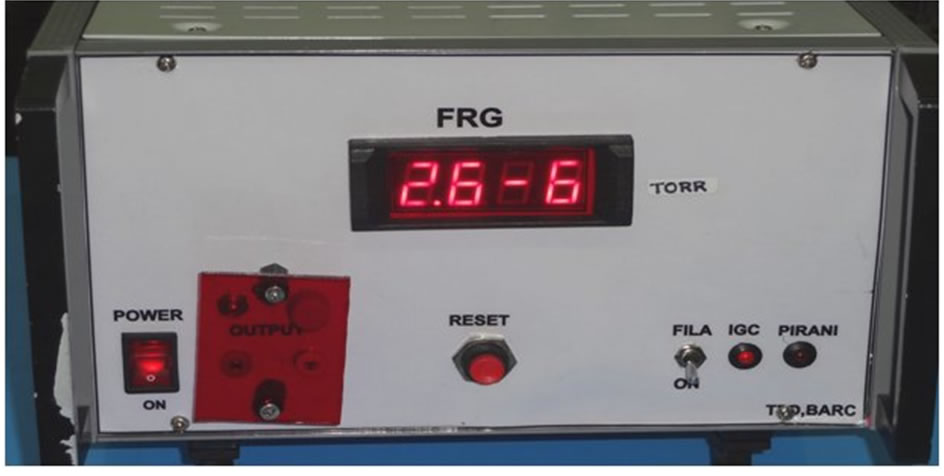

The full range vacuum gauge developed in BARC, is a single flange mounted gauge that works over the entire pressure range of 760 Torr to less than 10-9 Torr. Thus the gauge requires only one port in the vacuum chamber and only one electronic control unit.
Vacuum Gauges are used to measure low pressures, typically in the range 760 Torr to 10-9 Torr, in closed vacuum chambers. Vacuum measurement forms a critical requirement for understanding processes happening in various instruments such as charged particle accelerators, surface analytical equipment, mass spectrometers, etc.
In order to cover the typical vacuum range of 760 Torr to 10-9 Torr, several gauges are usually employed, since there is no single gauge that can work over the entire pressure range mentioned. This means that the vacuum chamber should have two or three ports for connecting different vacuum gauges covering different ranges and different electronic control units with respective cables for connecting the gauges to the control units. This is a cumbersome task.
The full range vacuum gauge developed in Technical Physics Division, BARC, is a single flange mounted gauge that works over the entire pressure range of 760 Torr to less than 10-9 Torr. Thus the gauge requires only one port in the vacuum chamber and only one electronic control unit. The gauge along with the special cable and electronic control unit are available for technology transfer to interested parties.
Vacuum Gauges are used to measure low pressures, typically in the range 760 Torr to 10-9 Torr, in closed vacuum chambers. Vacuum measurement forms a critical requirement for understanding processes happening in various instruments such as charged particle accelerators, surface analytical equipment, mass spectrometers, etc.
In order to cover the typical vacuum range of 760 Torr to 10-9 Torr, several gauges are usually employed, since there is no single gauge that can work over the entire pressure range mentioned. This means that the vacuum chamber should have two or three ports for connecting different vacuum gauges covering different ranges and different electronic control units with respective cables for connecting the gauges to the control units. This is a cumbersome task.
The full range vacuum gauge developed in Bhabha Atomic Research Centre, Mumbai, is a single flange mounted gauge that works over the entire pressure range of 760 Torr to less than 10-9 Torr. Thus the gauge requires only one port in the vacuum chamber and only one electronic control unit.
The gauge consists of a specially designed Pirani Gauge working in the range 760 Torr to 10-3 Torr and a miniature hot-cathode Ionization gauge working in the range 10-2 Torr to 10-9 Torr. Both the gauges are mounted on a single ultrahigh vacuum feedthrough comprising of 9-pins.
The current carrying Pirani filament is heated and forms one arm of the wheatstone bridge of the sensing circuit. The change in the Filament temperature produces a change in the electrical resistance and by measuring the resistance the pressure in the vacuum chamber is determined.
The Hot cathode Ion gauge is a Bayard Alpert type Gauge which has triode structure comprising Two Yttria-coated Iridium filaments, a hexagonal grid and a central anode in the form of thin wire. The potentials of the three electrode are so arranged that the electrons are emitted by the heated filament of the gauge are collected by the grid. During their travel, electrons collide with the gas molecules and produce ions of the gaseous species present in the vacuum system. These ions are collected by the collector and measured as ion current. The emission current (Ie) is stabilized using feedback technique by controlling the power to the filament via sensing the electrons collected by the grid. The measurement of ion current collected by the collector is a direct measure of the pressure in the vacuum chamber.
An electronic control unit monitors the pressure continuously and seamlessly switches between the gauges depending on the pressure in the vacuum chamber. The gauge is mounted on a CF35 (70mm OD) standard conflat flange recessed port. Special 9-pin shielded cable connects the gauge to the electronic control unit. Several protection measures have been included in the electronic control unit to avoid filament burn-out due to sudden increase in ambient pressure. The error in the pressure reading of the Pirani gauge is less than +/- 10%, while the error in the pressure reading of the Ionization gauge is less than +/- 15%.
DETAILED SPECIFICATIONS
| Working Range | 760 Torr to 10-9 Torr |
|---|---|
| Working principle | Combined dual gauge (Pirani + Hot Cathode Ionization Gauge) |
| Mounting Arrangement | Single CF35 (70mm OD) conflat flange (recessed) |
| Working environment | Clean high and ultrahigh vacuum systems (not suitable for corrosive environments) |
| Error in measurement | +/- 10% in Pirani Gauge (760 – 10-3 Torr) +/- 15% in Hot Cathode Ionization Gauge (10-3 to 10-9 Torr) |
| Gauge calibration | Against a secondary standard, for Nitrogen or Air. The gauge should to be calibrated if it will used for different gases. |
| Materials exposed to vacuum | Tungsten, Yttria coated Iridium, Alloy 52 and 7052 corning glass |
| Display | Seven segment LED Display.(Exponent and Mantissa Form) |
| Computer Interface | RS-232 serial link |
| Instrument Chasis | 480mm* 250mm*132mm |
| Mains | 230V AC @50Hz, Single phase |
MANPOWER


